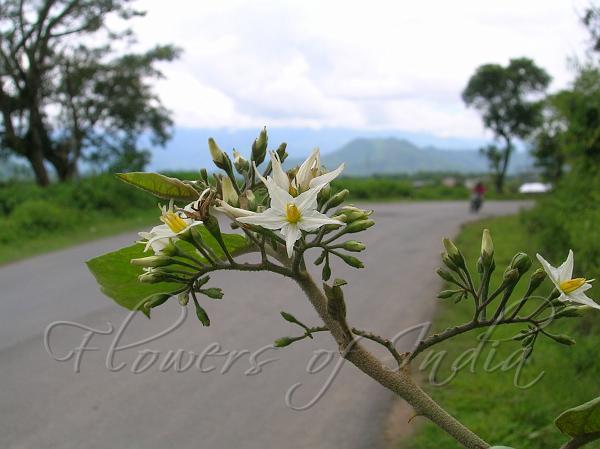|
| Turkey Berry |
|

|

| File size | 592892 |
| Original date | 7/6/05 12:27 PM |
| Resolution | 2048 x 1536 |
| Flash | Flash did not fire, auto |
| Focal length | 8.0mm |
| Exposure time | 1/236s |
| Aperture | 5.5 |
| Focus Distance | |
| Metering Mode | Partial |
| Camera make | NIKON |
| Camera model | E3700 |
| Sensor type |
|
|
|
Photo: |
Botanical name: Solanum torvum Family: Solanaceae (Potato family)
Turkey berry is a broadleaved, evergreen, shrub 1.2-1.7 m or more tall.
Stem and branches are sparsely prickly, star-shaped woolly.
Leaves are 9-13 x 5-10.5 cm, ovate-wavy, star-shapedly velvet-hairy woolly, may have prickles along
the midvein.
Flowers are pale white, in compact panicle-like cymes. Flower-cluster-stalks
are stout, 1.0-4.0 cm long. The stems are armed with stout, straight or lightly curved
prickles. The alternate leaves are elliptical in shape, and range from unlobed to strongly lobed.
Fruit are small yellow berries 1-1.5 cm in diameter. Once established, it can sprout
from its roots, creating large thickets that could displace other
vegetation. Turkey berry is found throughout the world’s tropical
regions, although it is native to Central America. The young fruits are edible after cooking.
Medicinal uses: Whole plant is used as sedative, diuretic and stomachic. Fruit decoction is used to cure cough;
useful in liver and spleen enlargement. Pounded roots are applied in cracks in the feet.
Whole plant is used as sedative, diuretic and stomachic. Fruit decoction is used to cure cough;
useful in liver and spleen enlargement. Pounded roots are applied in cracks in the feet.
Medicinal uses:
 Whole plant is used as sedative, diuretic and stomachic. Fruit decoction is used to cure cough;
useful in liver and spleen enlargement. Pounded roots are applied in cracks in the feet.
Whole plant is used as sedative, diuretic and stomachic. Fruit decoction is used to cure cough;
useful in liver and spleen enlargement. Pounded roots are applied in cracks in the feet.
| Identification credit: Tabish | Photographed in Imphal & Bangalore. |
• Is this flower misidentified? If yes,